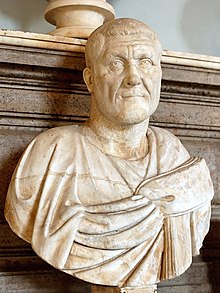235: Difference between revisions
Content deleted Content added
m Disambiguating links to Wu (link changed to Eastern Wu) using DisamAssist. |
→Roman Empire: add information |
||
| Line 15: | Line 15: | ||
==== Roman Empire ==== |
==== Roman Empire ==== |
||
* Said to have been the beginning of the decline of the Roman empire. |
* Said to have been the beginning of the decline of the Roman empire. |
||
* [[March 19]] – Emperor [[Alexander Severus]] and his mother [[Julia Avita Mamaea|Iulia Mamaea]] are [[murder]]ed by their own soldiers near [[Moguntiacum]] (modern [[Mainz]]); [[Legio XXII Primigenia|Legio XXII ''Primigenia'']] mutinies. The [[Severan dynasty]] ends. |
* [[March 19]] – Emperor [[Alexander Severus]] and his mother [[Julia Avita Mamaea|Iulia Mamaea]] are [[murder]]ed by their own soldiers near [[Moguntiacum]] (modern [[Mainz]]); [[Legio XXII Primigenia|Legio XXII ''Primigenia'']] mutinies. The [[Severan dynasty]] ends. This marks the epoch event of the Crisis of the Third Century. |
||
* [[March 20]] – [[Maximinus Thrax]], age 62, is proclaimed Augustus. He is not a senator but the second emperor of the equestrian order since Macrinus 17 years earlier. Maximinus had been a common soldier in the army, serving in the Auxilia and the Imperial Horseguards to become governor of several provinces. |
* [[March 20]] – [[Maximinus Thrax]], age 62, is proclaimed Augustus. He is not a senator but the second emperor of the equestrian order since Macrinus 17 years earlier. Maximinus had been a common soldier in the army, serving in the Auxilia and the Imperial Horseguards to become governor of several provinces. |
||
* Widely considered to be the beginning of the [[Crisis of the Third Century]]: The [[Roman Empire]] is under pressure by the [[Alamanni]], [[Franks]], [[Goths]], [[Quadi]] and [[Sassanid Empire|Sassanids]] ([[Sasanian Empire|Persia]]). |
* Widely considered to be the beginning of the [[Crisis of the Third Century]]: The [[Roman Empire]] is under pressure by the [[Alamanni]], [[Franks]], [[Goths]], [[Quadi]] and [[Sassanid Empire|Sassanids]] ([[Sasanian Empire|Persia]]). |
||
Revision as of 22:31, 1 December 2017
| Millennium: | 1st millennium |
|---|---|
| Centuries: | |
| Decades: | |
| Years: |
| 235 by topic |
|---|
| Leaders |
| Categories |
| Gregorian calendar | 235 CCXXXV |
| Ab urbe condita | 988 |
| Assyrian calendar | 4985 |
| Balinese saka calendar | 156–157 |
| Bengali calendar | −358 |
| Berber calendar | 1185 |
| Buddhist calendar | 779 |
| Burmese calendar | −403 |
| Byzantine calendar | 5743–5744 |
| Chinese calendar | 甲寅年 (Wood Tiger) 2932 or 2725 — to — 乙卯年 (Wood Rabbit) 2933 or 2726 |
| Coptic calendar | −49 – −48 |
| Discordian calendar | 1401 |
| Ethiopian calendar | 227–228 |
| Hebrew calendar | 3995–3996 |
| Hindu calendars | |
| - Vikram Samvat | 291–292 |
| - Shaka Samvat | 156–157 |
| - Kali Yuga | 3335–3336 |
| Holocene calendar | 10235 |
| Iranian calendar | 387 BP – 386 BP |
| Islamic calendar | 399 BH – 398 BH |
| Javanese calendar | 113–114 |
| Julian calendar | 235 CCXXXV |
| Korean calendar | 2568 |
| Minguo calendar | 1677 before ROC 民前1677年 |
| Nanakshahi calendar | −1233 |
| Seleucid era | 546/547 AG |
| Thai solar calendar | 777–778 |
| Tibetan calendar | 阳木虎年 (male Wood-Tiger) 361 or −20 or −792 — to — 阴木兔年 (female Wood-Rabbit) 362 or −19 or −791 |

Year 235 (CCXXXV) was a common year starting on Thursday (link will display the full calendar) of the Julian calendar. At the time, it was known as the Year of the Consulship of Severus and Quintianus (or, less frequently, year 988 Ab urbe condita). The denomination 235 for this year has been used since the early medieval period, when the Anno Domini calendar era became the prevalent method in Europe for naming years.
Events
By place
Roman Empire
- Said to have been the beginning of the decline of the Roman empire.
- March 19 – Emperor Alexander Severus and his mother Iulia Mamaea are murdered by their own soldiers near Moguntiacum (modern Mainz); Legio XXII Primigenia mutinies. The Severan dynasty ends. This marks the epoch event of the Crisis of the Third Century.
- March 20 – Maximinus Thrax, age 62, is proclaimed Augustus. He is not a senator but the second emperor of the equestrian order since Macrinus 17 years earlier. Maximinus had been a common soldier in the army, serving in the Auxilia and the Imperial Horseguards to become governor of several provinces.
- Widely considered to be the beginning of the Crisis of the Third Century: The Roman Empire is under pressure by the Alamanni, Franks, Goths, Quadi and Sassanids (Persia).
China
By topic
Religion
- September 28 – Pope Pontian resigns, the first to abdicate, because he and Hippolytus, church leader of Rome, are exiled to the mines of Sardinia. Emperor Maximinus persecutes the Christians.
- November 21 – Pope Anterus succeeds Pontian as the nineteenth pope.
- Origen makes revisions to the Septuagint.
Births
- Sun Xiu, emperor of the Chinese Kingdom of Wu (d. 264)
Deaths
- March 19 – Severus Alexander, Roman Emperor (b. 208)
- October – Pope Pontian
- Hippolytus, Christian writer (b. 170)
- Julia Avita Mamaea, mother of Alexander Severus (b. c. 180)
- Yang Yi, minister of Shu Han
- Chen Zhen, minister of Shu Han
- Kebineng, Xianbei chieftain
- Guo Nüwang, empress of Cao Wei (b. 184)
